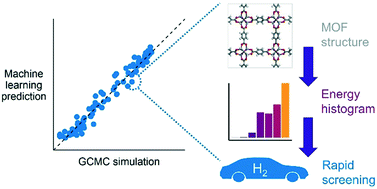当前位置:
X-MOL 学术
›
Mol. Syst. Des. Eng.
›
论文详情
Our official English website, www.x-mol.net, welcomes your
feedback! (Note: you will need to create a separate account there.)
Energy-based descriptors to rapidly predict hydrogen storage in metal–organic frameworks†
Molecular Systems Design & Engineering ( IF 3.2 ) Pub Date : 2018-11-01 00:00:00 , DOI: 10.1039/c8me00050f Benjamin J. Bucior 1, 2, 3, 4 , N. Scott Bobbitt 1, 2, 3, 4 , Timur Islamoglu 2, 3, 4, 5 , Subhadip Goswami 2, 3, 4, 5 , Arun Gopalan 1, 2, 3, 4 , Taner Yildirim 4, 6, 7, 8 , Omar K. Farha 1, 2, 3, 4, 5 , Neda Bagheri 1, 2, 3, 4, 9 , Randall Q. Snurr 1, 2, 3, 4
Molecular Systems Design & Engineering ( IF 3.2 ) Pub Date : 2018-11-01 00:00:00 , DOI: 10.1039/c8me00050f Benjamin J. Bucior 1, 2, 3, 4 , N. Scott Bobbitt 1, 2, 3, 4 , Timur Islamoglu 2, 3, 4, 5 , Subhadip Goswami 2, 3, 4, 5 , Arun Gopalan 1, 2, 3, 4 , Taner Yildirim 4, 6, 7, 8 , Omar K. Farha 1, 2, 3, 4, 5 , Neda Bagheri 1, 2, 3, 4, 9 , Randall Q. Snurr 1, 2, 3, 4
Affiliation

|
The low volumetric density of hydrogen is a major limitation to its use as a transportation fuel. Filling a fuel tank with nanoporous materials, such as metal–organic frameworks (MOFs), could greatly improve the deliverable capacity of these tanks if appropriate materials could be found. However, since MOFs can be made from many combinations of metal nodes, organic linkers, and functional groups, the design space of possible MOFs is enormous. Experimental characterization of thousands of MOFs is infeasible, and even conventional molecular simulations can be prohibitively expensive for large databases. In this work, we have developed a data-driven approach to accelerate materials screening and learn structure–property relationships. We report new descriptors for gas adsorption in MOFs derived from the energetics of MOF–guest interactions. Using the bins of an energy histogram as features, we trained a sparse regression model to predict gas uptake in multiple MOF databases to an accuracy within 3 g L−1. The interpretable model parameters indicate that a somewhat weak attraction between hydrogen and the framework is ideal for cryogenic storage and release. Our machine learning method is more than three orders of magnitude faster than conventional molecular simulations, enabling rapid exploration of large numbers of MOFs. As a case study, we applied the method to screen a database of more than 50 000 experimental MOF structures. We experimentally validated one of the top candidates identified from the accelerated screening, MFU-4l. This material exhibited a hydrogen deliverable capacity of 47 g L−1 (54 g L−1 simulated) when operating at storage conditions of 77 K, 100 bar and delivery at 160 K, 5 bar.
中文翻译:

基于能量的描述符可快速预测金属有机框架中的氢存储†
氢的低体积密度是其用作运输燃料的主要限制。如果可以找到合适的材料,则用金属-有机骨架(MOF)等纳米孔材料填充燃料箱可以大大提高这些燃料箱的可输送能力。但是,由于MOF可以由金属节点,有机连接基和官能团的许多组合制成,因此可能的MOF的设计空间很大。数以千计的MOF的实验表征是不可行的,甚至常规的分子模拟对于大型数据库而言也可能过于昂贵。在这项工作中,我们开发了一种数据驱动的方法来加速材料筛选并学习结构与属性之间的关系。我们报道了MOF中气体吸附的新描述,这些气体是由MOF与客体相互作用的能量得出的。-1。可解释的模型参数表明,氢气与骨架之间的吸引力较弱,是低温储存和释放的理想选择。我们的机器学习方法比传统的分子模拟快三个多数量级,从而可以快速探索大量MOF。作为案例研究,我们将该方法用于筛选包含5万多个实验MOF结构的数据库。我们通过实验验证了从加速筛选中鉴定出的最佳候选药物之一MFU-4 l。当该材料在77 K,100 bar的储存条件下和160 K,5 bar的储存条件下运行时,其氢气可输送容量为47 g L -1(模拟为54 g L -1)。
更新日期:2018-11-01
中文翻译:

基于能量的描述符可快速预测金属有机框架中的氢存储†
氢的低体积密度是其用作运输燃料的主要限制。如果可以找到合适的材料,则用金属-有机骨架(MOF)等纳米孔材料填充燃料箱可以大大提高这些燃料箱的可输送能力。但是,由于MOF可以由金属节点,有机连接基和官能团的许多组合制成,因此可能的MOF的设计空间很大。数以千计的MOF的实验表征是不可行的,甚至常规的分子模拟对于大型数据库而言也可能过于昂贵。在这项工作中,我们开发了一种数据驱动的方法来加速材料筛选并学习结构与属性之间的关系。我们报道了MOF中气体吸附的新描述,这些气体是由MOF与客体相互作用的能量得出的。-1。可解释的模型参数表明,氢气与骨架之间的吸引力较弱,是低温储存和释放的理想选择。我们的机器学习方法比传统的分子模拟快三个多数量级,从而可以快速探索大量MOF。作为案例研究,我们将该方法用于筛选包含5万多个实验MOF结构的数据库。我们通过实验验证了从加速筛选中鉴定出的最佳候选药物之一MFU-4 l。当该材料在77 K,100 bar的储存条件下和160 K,5 bar的储存条件下运行时,其氢气可输送容量为47 g L -1(模拟为54 g L -1)。











































 京公网安备 11010802027423号
京公网安备 11010802027423号